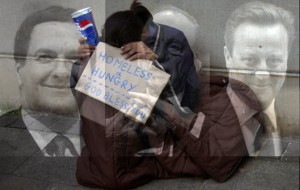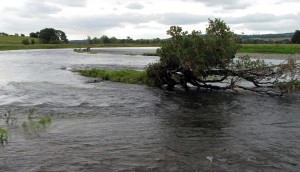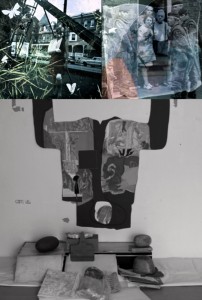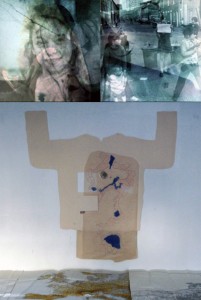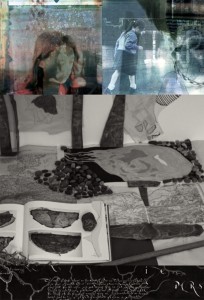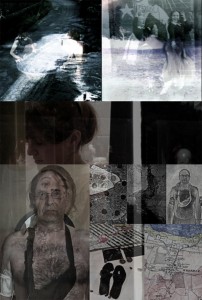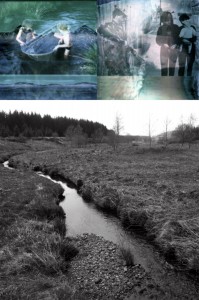Shortly after I’d posted this I opened today’s Guardian and found Neal Ascherson’s article Independence day has already dawned. Since it relates to much of what I’d written, it seems sensible to amend what I’d written earlier so as to take account of some of Ascherson’s comments.
I find it a bit odd when someone gives themselves a monolithic identity – as in ‘I’m English’. This may be because I was born in London, had a Scottish grandmother, spent my childhood in Kent, Dorset, and Inverness-shire, took my degrees in Leeds and London, now live in Bristol (while spending part of each summer in County Durham), have working links to Europe (the Netherlands and the Irish Republic recently), carry a British passport, and am close to good friends in the USA and Australia. Or it may be because I understand myself as inhabiting a polyverse, one in which it makes no more sense to think reductively about identity than to try to configure my lifeworld as a monolithic ‘life-as’.
Whatever the the case, I wonder if I’m the only person to sense something weirdly indicative about Sarah Lucas representing Britain at the Venice Biennale, given the political situation in Britain following the election?
It seems to me that Lucas, along with Tracy Emin, has always been a poster girl for a particular cultural position – the knowing metropolitan ‘bohemianism’ of the YBAs if you like – that is highly specific to London and the South East, while presenting itself as something much more ‘representative’. (If that seems too big a generalisation, think about what might have been if their cultural sensibilities reflected the urban worlds of, say, Cardiff, Glasgow, or even Newcastle. If they’d been working in those cities – famous for their Hen Nights and heavy drinking, in-your-face party girls – their work would almost certainly had other elements in the mix, other specific cultural and historical traces entirely absence from the bland literalism that signifies so much of the YBA’s work).
But why place Lucas in the political context thrown up by the British election, given that the critic Laura Cumming writes that at the Biennale her work “stands out purely by having no political content whatsoever”? Because, as Ascherson points out, the question of ‘Great Britain’, of “how to save the union” is now quite simply meaningless because “the 1707 union between England and Scotland is already dead. As a piece of architecture, it was abandoned in 1999, when the devolved Scottish parliament met” … “Today, what exists instead is a constantly changing set of relationships between London and Edinburgh, confused by feeble constitutional wheezes that arrive too late”. So what exactly is this notion of a cultural ‘British-ness’ that Sarah Lucas is supposed to be in some sense representing? In my view it’s a political slight-of-hand we’d do well to dispense with.
What is increasingly clear about the rise of the SNP is that, while in one sense it can be said to represent a ‘Nationalist’ politics (although not, I would suggest, in the narrow sense that Plaid Cymru does because of the issue of the Welsh language). Rather it is intended to deliberately evoke an alternative set of social values. In short, the SNP is in large part about contesting the assumptions of the two traditional mainstream parties, for whom both the Westminster status quo and the economics of austerity are simply taken as given. My feeling then is that Sarah Lucas represents ‘Britain’ in very much the same way that the recently elected Tory Government does. That Government, as Ascherson notes, is now working from the presupposition that: “Westminster is well on the way to becoming an English parliament anyway. As Michael Kenny writes in his book The Politics of English Nationhood, ‘As an unintended consequence of devolution … an increasingly Anglicised polity has quietly emerged as an incubus at the heart of the UK state … the Westminster parliament is gradually evolving into an English-focused one'”. And an England that, increasingly, is identified by those in power with the City of London and the South East.
I’m suggesting then that both Lucas’ art and the Tory party ideology are, in their different ways, inseparable from a tacit understanding of an anachronistic and exclusive ‘English-ness’ dominated by a particular (and particularly arrogant), set of parochial cultural and economic presuppositions that regard London and the South East as ‘the heart of Britain’. (As Lucy Lippard observed in The Lure of the Local (1997): “The urban ego is in fact parochial; New Yorkers (like Parisians or Bostonians) are among the most provincial people in the world” I would argue that this is equally true of the London art world). I see just that kind of provincialism reflected in much work by the YBAs (now not so young, of course), and by the fact that Lucas was one of 200 public figures who signed a letter to The Guardian opposing Scottish independence in the run-up to the referendum. That stance, after all, was really little more than a reactionary denial of the different values that let those living in Scotland to reject Tory ideology.
Whether my view is justifiable depends, in no small part, on whether you think the SNP is primarily motivated by the nationalism that socialism still tends to reject out of hand. (Notwithstanding that it is capitalism, and not socialism, that dominates the global stage). Personally, and as Nicola Sturgeon has made very plain post-referendum, I see the SNP as first and foremost an anti-austerity party that, in the name of those living in Scotland, rejects a political and cultural status quo that sees the term ‘Britain’ as largely referring to an ‘England’ that presupposes the superiority of the South east – of London and the Home Counties. (Ascherson appears to share this view, writing that Sturgeon’s “nationalism is instrumental rather than existential: independence as the means to social justice and prosperity, not the end”).
Acknowledging other lifeworlds
I first came across Lois Williams when she was studying to be a teacher at Goldsmiths College in 1975-6. (My wife studied there the same year). However, I only really registered her work when it was included in the New North exhibition at Tate Liverpool in 1990. Later I read the exchange between Williams and Iwan Bala in his Certain Welsh Artists: Custodial Aesthetics in Contemporary Welsh Art (1999). My interest in her work is part and parcel of a wider interest in the cultural mechanisms that ignore and suppress lifeworlds that do not conform to the presuppositions of the status quo; that reduce them to monolithic identities or a ‘life-as’. Cultural work that opposes those mechanisms is what animates my interest in the Irish artist Deirdre O’Mahony and the farmer and and performer artist Ffion Jones, both of who I mentioned in my last post, and in projects like Hannah Leighton-Boyce’s The Event Of The Thread.
It is sometimes said that ‘comparisons are odious’ but, thinking about social tensions as articulated in contemporary politics and culture in the UK recently, I can’t help ponder the differences between Williams’ A Living Position (1997), Lucas’ Au Naturel (1994), and Tracy Emin’s My Bed (1998) – all of which use found objects located within a bed-like space.
Williams’ contribution to the chapter co-authored with Iwan Bala seems to me to set her apart from the values of the ‘British’ (in actuality ‘South Eastern English’) art world of which I’m suggesting Sarah Lucas’ work is indicative. In that chapter Williams writes: “I have always been interested in the parallels between art and farming” (Bala p. 142), something I cannot imagine a contemporary ‘English’ artist saying. Equally ‘un-English’ (in the reductive sense I’ve indicated) is Williams’ willingness to teach for many years in a secondary school in Sheffield while practicing as an artist, part of her clear sense of the importance of maintaining her links with Cefn, St Asaph.
Nothing could be further from the cultural presuppositions that inform Tracy Emin’s My Bed that, with its overwhelming emphasis on the artist as isolated individual – the stained bed sheets and litter of condoms, period stained pair of knickers and personal everyday objects. That work seems to me to stand as an embodiment of the preoccupations of those YBAs who evoked the reductive hedonism and consequent anxieties of the culture of possessive individualism. A culture predicated on the consumption of a ‘quasi-bohemianism’ as fundamental to the ad-man’s focus on consumption, sex, and identity conceived in terms of money as a route to a rampant individualistic exceptionalism (to celebrity, to put it at its simplest). Both Tory politics and the art world that sends Lucas to ‘represent Britain’ in Venice can only maintain power and status by ignoring or marginalising alternative, less reductive, values.
What in my view links the work of Lois Williams and Hannah Leighton-Boyce’s The Event Of The Thread is precisely what is absent in the work of Sarah Lucas and Tracy Emin. Both Williams and Leighton-Boyce are, it seems to me, centrally concerned with the specificity of community and place as these are constellated in and through a particular taskscape. In short, they understand that working relationships, rather than leisure and consumption, as the formative element in social identity. In Williams’ case the relationship of the Welsh farmer to the land farmed and those whom it feeds, and in Leighton-Boyce’s the traditional relationship between cloth manufacture, place, weather, the act of stretching woollen cloth on tenter frames, and their resilient trace in language despite massive social change in areas such as the Rossendale Valley (also known as the Forest of Rossendale) in Lancashire. To work out of that understanding is already to act politically – not as a metropolitan provincial but as someone conscious of being placed in the multiplicity of relationships that Felix Guattari characterises as constituting ecosophy. Which is why just how we approach creative work has everything to do with issues of multiple lifeworlds, identity, culture, and politics.
In Hannah Leighton-Boyce’s book documenting and celebrating The Event Of The Thread, there are two photographs of her spinning wool (one publicly, outside the Robin Hood pub in Helmshore, the other on the great wheel at Helmshore Mills Textile Museum). For me these are extraordinarily resonant in a variety of ways with elements in both Ffion Jones’ performance Dear Mike Jagger – in which she span wool in order to enwrap a ram’s skull – and with Lois Williams use of wadding in works like Journey (1989) and A Living Position (1997). These acts and traces of acts, taken together, evoke the constitution of a weave of resonances that speaks of the interdependence of social, individual, and animal tasks capes; of a mycelial mesh of place, activity and identity, that in turn evoke a sense of cultural – and ultimately political – value utterly at odds with both a reductive Tory ideology predicated on the global economic bottom line and the maintenance of existing wealth and power, and with the values of the London-based cultural mandarinate that sent Sarah Lucas to represent ‘Britain’ at Venice.
